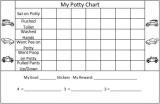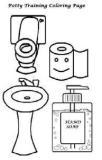Potty Training Regression, Accidents and Problems
Learn free tips on potty training regression to help eliminate accidents and problems you may be having in getting your child completely toilet trained. Regression can occur at any time for multiple reasons, especially in children with pervasive developmental disorders (PDD-NOS).
Things including; the arrival of a younger sibling, changes in the environment or seasons, illness, constipation, parental separation or divorce and inconsistency in routines (allowing disposable training pants part of the day), may all contribute to an increase in potty training accidents. It should also be noted that this is not uncommon as more than half of parents report at least some type of regression after becoming completely toilet trained.
Tips for Potty Training Regression
First try to determine if there is a specific cause that you can pinpoint about your child’s regression. If any of the causes listed above jump out at you, it may just be that your child needs understanding and time to adjust.
Parents may also need to take a few steps back and repeat part of the potty training in three days guide. This may include doing regular prompting every 30-45 minutes for a few days, practicing going to the potty a few times after an incident, and/or using free potty charts to provide some added reinforcement for your child through this rough patch.
If your child seems to be having potty training regression shortly after you trained, he/she may not be ready to become completely trained. So, be sure to check out the necessary requirements for when to start potty training.
Purposeful Potty Training Regression
You should also be careful that the accidents are not done purposefully as a way to avoid certain activities. We actually went through this with our son during the first year after he was trained.
He began having problems whenever he was put into a time out at preschool or while awake during attempted naps at daycare. When it became blatantly obvious that he was having them on purpose to avoid the activity, we used a slightly different approach than normal in response to the accidents.
First, we made sure to follow through on the activity despite having to change his clothes. We had him help to clean up the mess and put cloth training pants with a vinyl cover on instead of his “big boy” pants.
It was simply stated to him that “Poop and pee go in the potty” and if he was having trouble with this he would have to wear the not so comfortable, bulky training pants that day, which avoided the majority of a mess in future incidents (part of the reinforcement for his behavior). It didn’t take long for him to decide not to do them on purpose anymore.
Additional pages you may be interested in viewing:
• Training Overview• How to Start
• Using Behavior Charts
• Tips on Potty Training – DAY 2
• Guide for Public Places – DAY 3
• Potty Training a Bowel Movement

